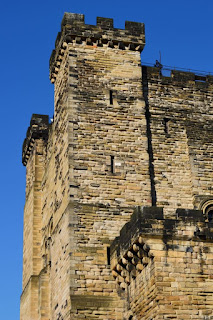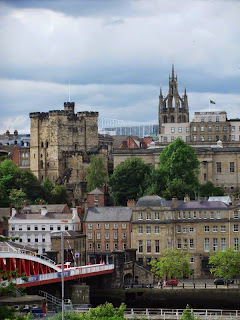The Castle is an archaeological site in Newcastle upon Tyne, England, that gives the City of Newcastle its name. The most visible evidence of the site now comprises two buildings, the Castle Keep and the The Black Gate, which are the remains of the Castle's square fortified stone tower (keep), and a fortified gatehouse (barbican).
Use of the site for defence dates from Roman times, when the site was known as a fort and settlement called Pons Aelius, guarding a bridge over the River Tyne. In 1080, a wooden motte and bailey style castle was built on the site of the Roman fort, which is the 'New Castle upon Tyne'. It was built by Robert Curthose, eldest son of William I (William the Conqueror), having returned south from a campaign against Malcolm III of Scotland. The stone Castle Keep was built between 1172 and 1177 by Henry II on the site of Curthose's castle. The Blackgate was added between 1247 and 1250 by Henry III.
The site is in the centre of Newcastle, and lies to the east of Newcastle Central Station. The 75 foot gap between the Keep and the Gatehouse is almost entirely filled by a railway viaduct, carrying the East Coast Main Line from Newcastle to Scotland. The Castle Keep and Blackgate pre-dated the construction of the Newcastle town wall, construction of which started sometime around 1265, and did not form part of it. Nothing remains of the Roman fort or the original motte and bailey castle. The Keep is a Grade I listed building, and a Scheduled Ancient Monument.
The Keep is owned by the City Council, who lease it to the Society of Antiquaries of Newcastle upon Tyne, who manage it as a visitor attraction. The society is based in the Blackgate, and use it to house a library and as a meeting place.
Earliest History
In about AD120 the Romans built the first bridge to cross the River Tyne at the place where Newcastle now stands. The bridge was called Pons Aelius or ‘Bridge of Aelius’, Aelius being the family name of Emperor Hadrian, who was responsible for the Roman wall built along Tyne-Solway Gap. The Romans built a fort to protect the river crossing which was at the foot of the Tyne Gorge. The fort was situated on rocky outcrop overlooking the new bridge, on the site of the later Norman castle. Little else is known about the roman fort that existed there.
At some unknown time in the Anglo-Saxon age, the site of Newcastle came to be known as Monkchester. During this time, a cemetery was established on the site of the Roman castle.
Norman Castle
In 1080 the Norman king, William I, sent his eldest son, Robert Curthose, north to defend the kingdom against the Scots. After his campaign, he moved to Monkchester and began the building of a ‘New Castle’. This was of the “motte-and-bailey” type of construction, a wooden tower on top of an earthen mound (motte), surrounded by a moat and wooden stockade (bailey). It was this new castle that gave Newcastle its name.
In 1095 the Earl of Northumbria, Robert de Mowbray, rose up against William Rufus and Rufus sent an army north to crush the revolt and to capture the castle. From then on the castle became crown property and was an important base from which the king could control the northern barons.
The New Stone Castle
Not a trace of the tower or mound of the motte and bailey castle remains now. Henry II replaced it with a rectangular stone keep, which was built between 1172 and 1177 at a cost of £1,444. A stone bailey, in the form of a triangle, replaced the previous wooden one. The master mason or architect, Maurice, also built Dover Castle. The great outer gateway to the castle, called ‘the Black Gate’, was built later, between 1247 and 1250, in the reign of Henry III. There were at that time no town walls and when attacked by the Scots, the townspeople had to crowd into the bailey for safety. It is probable that the new castle acted as a magnet for local merchants because of the safety it provided in dangerous times.
Additional protection to the castle was provided late in the 13th century when stone walls were constructed, with towers, to enclose the town. Ironically, the safety provided by the town walls led to the neglect of the fabric of the castle. In 1589, during the reign of Queen Elizabeth the castle was described as being ruinous. From the early 17th century onward this situation was made worse by the construction of shops and houses on much of the site, often using the fabric of the castle for building materials.
The Black Gate
The "Black Gate" was added to Newcastle Castle between 1247 and 1250, forming an additional barbican in front of the earlier north gate of the castle. It consisted of two towers with a passage running between them. On either side of the passage was a vaulted guardroom. There was a drawbridge at the front (facing west) and another at the rear. There was also a portcullis which could be raised and lowered to seal the entrance passage.
The original building would probably have had a flat roof, but in 1618 James I leased the gatehouse to a courtier, Alexander Stephenson. Stephenson substantially altered the gatehouse, rebuilding the upper floors. Stephenson then let the Black Gate out to various tenants, one of whom was a merchant, named Patrick Black. It was he who gave his name to the Black Gate.
Eventually houses were built along both sides of the passageway, and one part of the building became a public house. By the early part of the nineteenth century, the Black Gate had become a slum tenement, housing up to sixty people.
Blackgate was leased to the Society of Antiquaries of Newcastle upon Tyne in the 1880s, which extensively restored it between 1883 and 1885. It was the Society that added the top floor and pitched roof. The Society has held regular meetings there ever since. The drawbridges to the front and rear have been replaced by wooden footbridges.
English Civil War
In 1643, during the English Civil War, the Royalist Mayor of Newcastle, Sir John Marley, repaired the keep and probably also refortified the castle. In 1644 the Scottish army crossed the border in support of the Parliamentarians and 40,000 Scottish troops besieged Newcastle for three months until the garrison of 1,500 surrendered.
During the 16th to the 18th century, the keep was used as a prison. By 1800 there were more than fifty houses within the boundaries of the castle housing several hundred people.
Nineteenth century
In 1809 Newcastle Corporation bought the keep and provided it with a roof and battlements. In addition the private dwellings within the castle boundaries were demolished. In the mid 19th century the arrival of the railway in Newcastle led to a viaduct to be constructed to the north of the keep and crossing the site of the castle. As a result, only the keep and the Black Gate now remain. The Black Gate is so called after Patrick Black, a tenant there in the 17th century. About that time a brick house, with mullioned and transomed windows was erected on top of the original, fortified gate.
Current building
The Keep is a Grade I listed building, and a Scheduled Ancient Monument. It is a roughly square building, measuring 62ft by 56ft and 81ft tall. The entrance leads via flights of stairs to the second floor and into the Great Hall, the largest room in the keep, measuring 30ft by 24ft.
The Black Gate was approached via a drawbridge across a moat. A wooden bridge has replaced the drawbridge. The original gate had a portcullis, and the recesses where this fitted can still be seen.
The keep is currently owned by Newcastle City Council and managed by the Society of Antiquaries of Newcastle upon Tyne, one of the world's oldest antiquarian societies.
The Castle Keep and Blackgate can be visited today. The keep is also notable in having the main East Coast railway line running through the center of the grounds. In particular, the battlements offer fine views over the River Tyne quayside, the cathedral and Newcastle Central station.
Description courtesy of Wikipedia.
17th January 2025

20th December 2023

Black Gate.




22nd June 2019
Taken from Gateshead.
27th December 2018
Taken from Gateshead.
24th December 2018
Taken from Gateshead.
26th September 2017
Taken from Gateshead.
19th September 2017
Curtain Walls.
Black Gate.
17th February 2016
Castle Keep.
The Castle Keep is separated from Black Gate by the East Coast Mainline which cuts right through it.
Black Gate.
22nd December 2015
Black Gate.
3rd December 2014
Taken from Gateshead.
9th July 2014
Taken from Gateshead.
8th June 2014
Taken from Gateshead.
26th May 2014
Black Gate.
23rd March 2013
Castle Keep.
Black Gate.
9th January 2012
Castle Keep.
12th September 2010
.jpg)
The East Coast Mainline.
The East Coast Mainline which separates The Castle Keep from Black Gate.
.jpg)
Millennium Bridge from The Castle Keep.
.jpg)
Central Station's diamond crossing from The Castle Keep.
.jpg)
Curtain Walls and The Swing Bridge from The Castle Keep.
.jpg)
The Tyne Bridge from The Castle Keep.
.JPG)
The High Level Bridge from The Castle Keep.
1st December 2009
Castle Keep.
Black Gate.
12th February 2009
Black Gate.
2009



Views from the top of the Castle.
Kindly submitted by reader of this site Richard Walker of Spital Tongues.
13th September 2008
r.jpg)
r.jpg)

r.jpg)
r.jpg)
r.jpg)
r.jpg)
r.jpg)
Inside the Castle.
7th June 2008
Black Gate.
4th June 2008
Castle Keep undergoing renovation.
11th February 2008
Castle Keep undergoing renovation.
Black Gate.
7th September 2007
Castle Stairs.
19th May 2007
Castle Keep from The Central Station.
28th December 2005
Castle Keep.
Black Gate.
10th September 2005
Black Gate.
Inside Castle Keep.
23rd August 2005
Black Gate.
View from the Castle.
21st August 2005
Castle Keep.
Black Gate.
View from the Castle.
Inside Castle Keep.
Old Photos
Castle Keep c.1930
The photograph has been taken from inside the gate tower looking down towards the Moot Hall. The walls of the gate tower are hung with miscellaneous objects including a coat of arms. Decorative pieces of stone are propped up against the walls. A man is standing further down the steps beside racks containing decorative pieces of stone. The Moot Hall is in the background.
Photo Courtesy of Newcastle Libraries
More old photos coming soon.
More Information:
- Newcastle Castle Official Website
- Wikipedia: The Castle, Newcastle
- Sitelines: Castle Garth, The Keep
- Sitelines: Castle Garth, The Black Gate
- Sitelines: Castle Garth, Castle Keep well, coins and a jug
- Sitelines: Castle Garth, Heron Pit, drawbridge pit etc
- Sitelines: Castle Garth, south postern tower and curtain wall
- Sitelines: Castle Garth, Barbican walls
- Sitelines: Castle Garth, north gate
- Sitelines: Castle Garth, ringwork
- Sitelines: Castle Garth, Great Hall
- Historic England: The Keep
- Historic England: The Black Gate
- Co-Curate: Newcastle Castle
Historical interest around Castle Garth:
- Sitelines: Castle Garth, chapel (Three Bulls Heads Public House)
- Sitelines: Castle Garth, Bridge Hotel
- Sitelines: Castle Garth, Northumberland County Hall (Vermont)
- Sitelines: Castle Garth, Moot Hall 1
- Sitelines: Castle Garth, Moot Hall 2
- Sitelines: Castle Garth, Presbyterian Meeting House
- Sitelines: Castle Garth, Half Moon Battery
- Sitelines: Castle Garth, Parrot's Houses
- Sitelines: Castle Garth, The Mount
- Sitelines: Castle Garth, Castle Inn
- Sitelines: Castle Garth, Bluebell Inn
- Sitelines: Castle Garth, railway viaduct
- Sitelines: Castle Stairs
- Sitelines: Castle Stairs, tenement dwellings
See my other photos around Castle Keep and Black Gate:













































.jpg)


.jpg)
.jpg)


.jpg)
.jpg)
.jpg)
.jpg)


r.jpg)
r.jpg)
r.jpg)
r.jpg)
r.jpg)
r.jpg)
r.jpg)
r.jpg)

r.jpg)





r.jpg)

r.jpg)
r.jpg)
r.jpg)
r.jpg)
r.jpg)
r.jpg)

r.jpg)






























I love the Castle Keep in the snow! Amazing photos!
ReplyDeleteThanks. :)
ReplyDelete